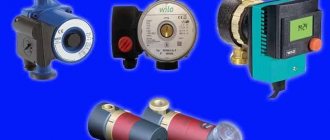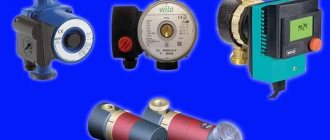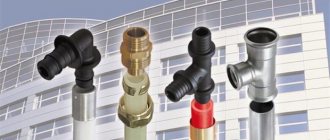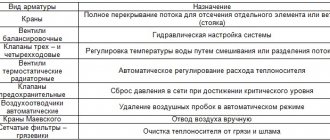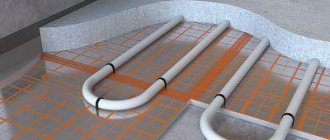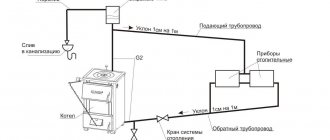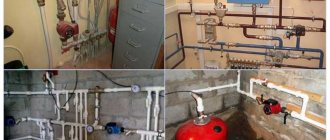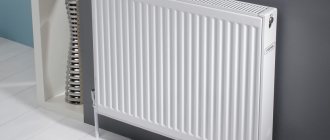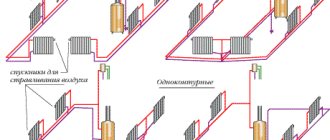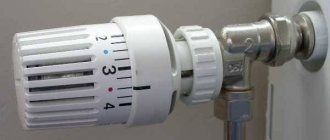The heating system of a private home is one of the basic life support elements. The comfort and coziness of the owner and his family depends on its effectiveness. The performance of the heating circuit is determined by many factors, of which the circulation pump plays a major role. It regulates the speed of movement of the coolant, determines the operating mode of the radiator system and heating boiler.
The absence of a pump makes heating dependent on natural physical processes. If errors were made during installation, circulation of the coolant without a pump will become impossible. rendering the entire heating circuit inoperative. In the conditions of our country, this issue is of fundamental importance and deserves careful consideration.
What it is?
The heating system is a closed circuit, the basis of which is a heating boiler. It is connected to a break in the heating circuit. The heated coolant leaves the boiler (straight line), passes in a circle, releasing thermal energy, and returns back to the boiler (return line or return line). The speed of water movement in the system determines the efficiency of its operation and fuel consumption for heating. The more actively the coolant moves, the less it cools. This makes it possible to reduce the fuel supply.
If the movement speed is low, a circulation pump is installed in the system. It creates a pressure that pushes the water in the required direction with the specified parameters. Fluid circulation stabilizes, becomes uniform and regulated. Please note that most modern heating boilers are equipped with their own circulation pumps. However, their power is often insufficient, especially with a complex, branched radiator circuit configuration. Many users use one heater to power not only the radiator system, but also the heated floor, which also creates noticeable resistance and requires additional power.
Installing a circulation pump on the return line allows you to stabilize the movement of the coolant and normalize the operation of the entire system as a whole.
Putting the pump into operation
Before connecting, the device is filled with water and air is pumped out. To release air, a bolt located on the rear of the motor is rotated. The air will begin to bleed. If water begins to flow out, it means the air has been released. The bolt returns to its original position. The valves on the suction and discharge sides open.
To switch the speed, use a speed switch located on the capacitor box.
Installation rules
- Installation is carried out in a ventilated, warm room.
- Installation is carried out after completion of welding and cleaning of the system.
- Closing valves are mounted at the inlet and outlet to the pump; this will prevent leaks and water from draining from the system when repairing the unit.
- To prevent breakdowns, the device is installed above or near the pipes.
- The device is connected to the pipeline so that the axis of the incoming and outgoing pipes coincide.
- To ensure quiet operation and absence of vibration, the unit is not installed close to the knee.
- The diameter of the pipe must match the diameter of the unit;
- Installation is carried out so that the direction of the arrow on the device coincides with the direction of the working fluid;
- The unit is installed taking into account accessibility if necessary.
Safety precautions
Before dismantling or installing the unit, it is disconnected from the network. Before dismantling the device, wait until it cools down.
When bleeding air, electrical parts are protected. To avoid damage, the pump is installed in a dry place.
Characteristics and installation diagram of the Gilex Compass pump
The temperature range of the room is from minus ten to plus fifty degrees Celsius.
Problems with Gilex and how to fix them
Circulators are reliable, but minor problems occur. To eliminate them you need to know the cause.
List of problems:
- When starting, the unit stops immediately. The reason is plaque between the impeller and the housing. The problem can be resolved by removing the plaque and unlocking the shaft;
- high noise level. The reason is air in the system or high water pressure. Fix the problem by bleeding air from the system and reducing the fluid speed;
- the unit does not start. The reason is that there is no voltage in the network, the capacitor has broken, deposits on the bearings have blocked the shaft. It is necessary to check the integrity of the cable and unblock the shaft;
If the operating rules are followed, the compass will serve for many years and does not require repair work.
Gilex Compasses are distinguished by their reliability and quality. Positive reviews confirm the quality of the devices.
Types and characteristics
A circulation pump is a centrifugal-type device, the impeller of which takes in and discharges liquid in a given direction. Like all similar devices, it works on suction and discharge with equal efficiency. Considering the specifics of use, these qualities are the main ones for it.
There are two main types of circulation pumps:
With wet rotor
The impeller of these pumps is mounted directly on the motor shaft. The pump housing is sealed, and a seal is placed on the shaft to protect against leaks. For household systems, such designs are considered the most suitable, since they do not create noise during operation. In addition, pumps with a wet rotor are capable of independently removing air pockets, and the liquid provides lubrication and cooling of the electric motor;
With dry rotor
The pump and motor are two separate units connected by a coupling or flange. Such designs are designed to work in large heating systems, as they can pump large volumes of liquids. The main disadvantage of dry pumps is the high noise level during operation, which is unacceptable at home.
Pumps: 1-With a wet rotor 2-With a dry rotor
Main technical characteristics of circulation pumps:
- Productivity . This is a value indicating the amount of coolant pumped by the pump per unit time. Determines the ability of the installation to provide a given speed of fluid movement for the available volume of the system;
- Napor . They are often confused, but this is a wrong approach. The pressure shows how high a given pump is capable of lifting a column of liquid. For heating systems of houses with several floors, this indicator is very important, since the hydraulic resistance in the circuits is high and must be overcome;
- Engine power . This indicator is important because insufficient power will not allow the pump to perform its tasks, and excess power will make the pipes make a lot of noise;
- Maximum temperature . Since we are talking about a heating system, the coolant is hot. If the pump is unable to operate under these conditions, it will seize, leak and other problems will occur. It must be taken into account that when rotating, the parts of the device heat up, and an additional rise in temperature sometimes becomes an excessive load for them.
- Connecting dimensions . Installing the pump is simple, but it requires the appropriate elements. They should be selected immediately after purchasing the pump, so as not to find yourself in a difficult position during installation;
- Manufacturer . This factor does not significantly affect the operation of the system, but products from well-known and reliable companies are much more durable and do not create such problems as products from little-known companies.
When purchasing, it is recommended to carefully study the technical characteristics of the pump and compare them with operating conditions in the existing circuit. You should choose devices that can withstand temperatures of 110°.
Basic parameters of heating pumps
There are not many parameters that you should pay attention to when choosing a device. In fact, there are only two of them - pressure and productivity (flow)
Pressure is the hydraulic resistance of the system that the pump is able to overcome. This value is measured in meters of water column. As a rule, the hydraulic resistance of the entire system is set by the highest point of the pipeline through which water circulates.
The pump's performance, measured in m³/h, shows how much liquid it can move through the pipeline per unit of time. Therefore, before choosing the required model, you need to know the exact volume of coolant in the system.
Important! Pressure and productivity are inversely proportional to each other. That is, the maximum pressure is achieved at zero supply
And, conversely, the maximum flow rate is possible at zero pipeline height.
It is the pressure-flow characteristic of the device that allows us to determine the model with optimal parameters for a specific system. At the same time, the standard formula - the more powerful, the better - is not entirely suitable for this case. Because this means purchasing a more expensive unit and increasing energy consumption.
Advantages and disadvantages
The advantages include:
- The ability to normalize the operation of the system, organize uniform and stable movement of the coolant.
- The ability to change the operating mode, which saves fuel.
- The high speed of movement allows you to heat the room in a short time.
- Some pipeline design flaws can be corrected after circulation is started.
- Reliability, ability to work in difficult conditions.
- Durability, undemanding, long service life.
- The ability to choose a model that is affordable and has suitable characteristics.
Disadvantages of devices:
- To operate the pump, you must be connected to a power supply.
- Electricity consumption increases, which will require additional costs.
- If there is a sudden power outage, the coolant circulation stops.
- Purchasing and installing the device into the system will also require certain expenses.
Expert opinion
Kulikov Vladimir Sergeevich
Despite some disadvantages, circulation pumps are popular devices, without which no system can be operated.
Features of Vilo TOP-S pumps
Such models are designed for rooms with an area of up to 1400 m2. With the help of these devices, it is possible to ensure accelerated circulation of coolant in all heating systems. Specifications:
- The equipment can operate within the range from -20 to +130 degrees, sometimes it is possible to increase the temperature to 140 degrees, but no more.
- The pipe is connected using a flange or thread.
- Maximum permissible pressure: 6, 10, 6/10, 16 bar (custom version).
- Three switching speeds.
- The alarm, engine and display functions have been expanded.
- Thermal insulating casing.
Pros and cons of Vilo
There are practically no negative reviews of Vilo circulation pumps, but there is a very high risk of buying a fake ; it is almost impossible to distinguish it from the real one. The equipment is in demand due to the following advantages:
- These devices are durable.
- There are several levels of protection.
- It is possible to manually switch engine speed.
Criterias of choice
Before you go to the store, you should make a list of system parameters - liquid volume, height differences, number of radiators, length, etc. This data will allow you to check the characteristics of the installation and select the most suitable instance. First of all, you need to make a list of the parameters of the boiler itself, since it provides the initial operating conditions of the heating circuit. We must be guided by the rule of maximum compliance - if a device is inferior to the requirements of the system, it cannot be purchased - it will not cope. Redundancy of characteristics is also harmful - noise will appear. It is necessary to try to find the best option to meet the needs of the heating circuit without excessive power or pressure.
Pump performance is calculated using the formula:
Q = 0.86 x P/dt, where
- Q—pump capacity (calculated);
- P—system power (thermal);
- dt is the difference in temperature at the outlet and inlet of the boiler.
The resulting value cannot be considered final. It is necessary to make an allowance for the height of the system, otherwise the actual performance will be much less. It should not be assumed that the height of the system can be balanced by the return. In practice, there is always hydraulic resistance created by radiators, turning units, branches and other system components. As a rule, for a two-pipe system (a simple loop without branches), productivity is calculated by multiplying the height by a coefficient of 0.7-1.1 (depending on the length and number of radiators), and for a collector system the coefficient is higher - 1.16-1.85.
The pump data sheet contains graphs demonstrating its performance at different speeds. It is necessary to find an option where the calculated value and the lift height will be approximately in the middle. This position is called the "midpoint". If the calculated parameters are in it, the device will operate in optimal mode.
Expert opinion
Kulikov Vladimir Sergeevich
You should not buy a pump “to grow.” If you plan to expand the circuit, you will have to buy a new device in any case. It is necessary to select a sample that matches the existing conditions.
Popular makes and models
Let's look at the most famous manufacturers of circulation pumps and their models:
WILO TOP-S 30/10 EM PN6/10
This is a massive device with a cast iron body and high productivity - up to 12 m3/hour. The pressure is also considerable - it provides a rise of the coolant by 10 m. The middle point on the graph gives a rise of 6 m3 by 6 m. The operating mode is three-speed. The disadvantages of this device are its large mass and weight, as well as increased starting current.
BELAMOS BRS 25/8G
Russian brand, but produced in the countries of Southeast Asia. At the same time, the price-quality ratio is quite good. The maximum productivity is 5.28 m3/h, and the pressure is 8 m. Externally, this device is a complete copy of the German Grundfos UPS, although its characteristics are somewhat inferior to the original.
Grundfos UPS 25-40 180
The best option for heating a medium-sized private house. Power - 45 W, productivity - 2.93 m3/h, pressure - 4m. The design is of a wet type, but is well insulated against leakage. Users note the low noise level during operation, high-quality assembly, and durability of the device.
Aquario AC 254-180
A good option for a private house with a two-pipe heating system. The productivity is 1.8 m3/h, which at first glance is not enough. However, for small systems this pump is the best option, which is not easy to find. The body is cast iron, the power is 48 W. The low cost of the device is an additional advantage.
Wilo Star-RS 30/6-180
The well-chosen characteristics of this pump allow it to be installed in the basement of a two-story house. It provides 5.5 m with a capacity of 3.5 m3/h. This combination makes it possible to work in a system serving a large area. Power consumption is 84 W, which is a bit much, but the low cost of the device balances out this drawback.
Grundfos UPS 32-80
This example of a powerful and durable pump is capable of pumping 11 m3 of liquid per hour. The case is bronze, resistant to all loads, both mechanical and temperature. A head of 7.5 m allows you to work even in three-story buildings. The device is expensive, but, according to the owners, it fully corresponds to this cost.
Wilo Yonos PICO 25/1-6
This device is equipped with an electronic control unit. Pressure - up to 6 m, productivity - 3.7 m3/h. This is not too much, but for a medium-sized two-story house it is quite suitable. There is an automatic air removal function, very useful in private heating systems. An additional plus is a convenient way to connect power. A sealed block is used that simply snaps into the socket.
The list of circulation pump models could go on for a long time, since the number of manufacturers is constantly increasing. At the same time, the most popular manufacturers are the companies considered. When choosing a suitable sample, it is recommended to take a closer look at the products of these companies.
Circulation pump dimensions
When choosing a pump for water heating at home, it is best to start by determining the simplest thing - its physical dimensions. Pumps used in private homes are small in size, but have two standard installation lengths:
- 180 mm (more popular today);
- 130 mm (old standard).
Other dimensions, diameter of connecting pipes, flow rate, pressure and power can be the same. However, the selection of 180 mm pumps in construction stores today is much larger.
Please note: a difference of 50 mm is quite a lot by plumbing standards, so when installing a pump in a water heating system, you should decide which size will be better, if only because of the available space in the box with the manifold.
